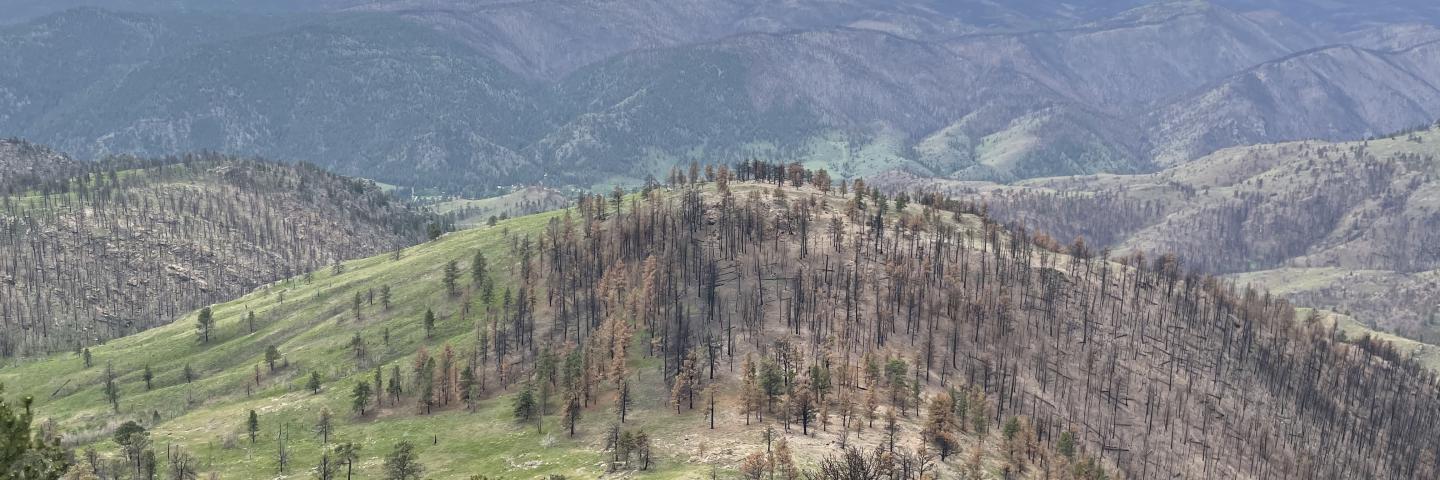
The Joint Chiefs' Landscape Restoration Partnership program (16 U.S.C. § 6592d) is working to improve the health and resilience of forest landscapes across National Forest System land and state, tribal, and private lands.
On This Page
The Joint Chiefs’ Landscape Restoration Partnership enables NRCS and the Forest Service to collaborate with agricultural producers and forest landowners to invest in conservation and restoration at a big enough scale to make a difference. Working in partnership, and at this scale, helps reduce wildfire threats, protect water quality and supply, and improve wildlife habitat for at-risk species.
Through the new three-year projects, landowners will work with local USDA experts and partners to apply targeted forestry management practices on their land, such as thinning, hazardous fuel treatments, fire breaks and other systems to meet unique forestry challenges in their area.
Joint Chief's Projects in Colorado
2019 Northern Front Range Joint Chief’s Landscape Restoration Project will use collaboratively developed guidance as well as principles and practices for the restoration of ponderosa pine and dry mixed-conifer forests of the Colorado Front Range, to meet the many and unique forest landscape challenges and opportunities in state
- This project highlights the benefits of multi-resource benefit, ecology-based forest restoration treatments in a collaborative and cross-boundary landscape. Whole tree removal was utilized to significantly reduce fuel loading, which proved beneficial for both understory plant community diversity as well as reducing fire risk. In September 2020, the Cameron Peak fire burned through the treated units on Shambhala’s property, and was instrumental in fire suppression efforts.
- This project also highlights the benefits of collaborative work across jurisdictional boundaries. The Joint Chiefs partnership between USDA USFS & NRCS allowed a landscape scale of treatment to be achieved in the watershed, tying together both mechanical treatments and prescribed fire units on private and federal. This scale of treatment squeezed the Cameron Peak Fire to a point where suppression became more feasible.
- This project would not have been possible without the close relationship that was formed between the landowners and the Fort Collins Conservation District/NRCS. This highlights the benefit of taking the time to build trust with clients and partners to address resource concerns in a meaningful way at meaningful scale.
National Joint Chief's Projects
Fy-22 selections bring the total number of Joint Chiefs’ Landscape Restoration projects to 110. Since 2014, these projects have delivered important forest and rangeland funding to 41 states and Puerto Rico. They provide private landowners with conservation resources that help them complete restoration efforts on their land for healthier and more resilient forest ecosystems.
The efforts of the Joint Chiefs' have produced outstanding results that can be explored here.
Ready to get started?
Contact your local service center to start your application.
How to Get Assistance
Do you farm or ranch and want to make improvements to the land that you own or lease?
Natural Resources Conservation Service offers technical and financial assistance to help farmers, ranchers and forest landowners.

To get started with NRCS, we recommend you stop by your local NRCS field office. We’ll discuss your vision for your land.
NRCS provides landowners with free technical assistance, or advice, for their land. Common technical assistance includes: resource assessment, practice design and resource monitoring. Your conservation planner will help you determine if financial assistance is right for you.
We’ll walk you through the application process. To get started on applying for financial assistance, we’ll work with you:
- To fill out an AD 1026, which ensures a conservation plan is in place before lands with highly erodible soils are farmed. It also ensures that identified wetland areas are protected.
- To meet other eligibility certifications.
Once complete, we’ll work with you on the application, or CPA 1200.
Applications for most programs are accepted on a continuous basis, but they’re considered for funding in different ranking periods. Be sure to ask your local NRCS district conservationist about the deadline for the ranking period to ensure you turn in your application in time.
As part of the application process, we’ll check to see if you are eligible. To do this, you’ll need to bring:
- An official tax ID (Social Security number or an employer ID)
- A property deed or lease agreement to show you have control of the property; and
- A farm number.
If you don’t have a farm number, you can get one from USDA’s Farm Service Agency. Typically, the local FSA office is located in the same building as the local NRCS office. You only need a farm number if you’re interested in financial assistance.
NRCS will take a look at the applications and rank them according to local resource concerns, the amount of conservation benefits the work will provide and the needs of applicants. View Application Ranking Dates by State.
If you’re selected, you can choose whether to sign the contract for the work to be done.
Once you sign the contract, you’ll be provided standards and specifications for completing the practice or practices, and then you will have a specified amount of time to implement. Once the work is implemented and inspected, you’ll be paid the rate of compensation for the work if it meets NRCS standards and specifications.

